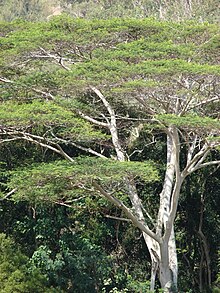Falcataria
| Falcataria | |
|---|---|

| |
| Falcataria moluccana | |
| Scientific classification | |
| Kingdom: | |
| (unranked): | |
| (unranked): | |
| (unranked): | |
| Order: | |
| Family: | |
| Subfamily: | |
| (unranked): | |
| Genus: | Falcataria (I.C.Nielsen) Barneby & J.W.Grimes[2]
|
| Species | |
Falcataria is a genus of flowering plants in the legume family, Fabaceae. It belongs to the monophyletic Mimosoid clade[2][1] in the subfamily Caesalpinioideae.[1] The genus has three species previously classified in the Falcataria section of the genus Paraserianthes by I.C. Neilsen. The distribution of these closely related species within the genus Falcataria links the wet tropics of north-east Australia to New Guinea, the Moluccas, Bismarck Archipelago, and the Solomon Islands east of Wallace's line similar to other plant taxa from the region.[3]
Species
- Falcataria moluccana (Miq.) Barneby & J.W.Grimes[4] (Native to New Guinea, Maluku Islands, the Solomon Islands, and the Bismarck Archipelago in Papua New Guinea)
- Falcataria pullenii (Verdc.) G.K. Brown, D.J. Murphy & P.Y. Ladiges (Native to Papua New Guinea)[3]
- Falcataria toona (Bailey), G.K. Brown, D.J. Murphy & P.Y. Ladiges (Native to Australia)[3]
Taxonomy
Falcataria moluccana had previously been classified within the genera Adenanthera, Albizia, and Paraserianthes before being moved to the new genus Falcataria, as the most widely distributed of the three species in the genus.[5][3] This widely cultivated timber tree is still called by the common name "albizia" in Hawaii and elsewhere.
The two additional species in the genus Paraserianthes (P. pullenii and P. toona) were identified using morphology to form the Falcataria group with P. falcataria (=Falcataria moluccana) by I.C. Neilsen.[6][7] A molecular phylogenetics study using genomic DNA and chloroplast DNA sequence data of these two species found them be closely related to Falcataria moluccana. These three species formed a well supported clade together that was distinctly different from Paraserianthes lophantha and so were moved to the genus Falcataria.[3]
- Falcataria pullenii (Verdc.) G.K. Brown, D.J. Murphy & P.Y. Ladiges[3] = Paraserianthes pullenii (Verdc.) I.C. Nielsen[6][7]
- Falcataria toona (Bailey), G.K. Brown, D.J. Murphy & P.Y. Ladiges[3] = Paraserianthes toona (F.M. Bailey) I.C. Nielsen[6][7]
References
- ^ a b c d The Legume Phylogeny Working Group (LPWG). (2017). "A new subfamily classification of the Leguminosae based on a taxonomically comprehensive phylogeny". Taxon. 66 (1): 44–77. doi:10.12705/661.3.
- ^ a b "Falcataria (I. C. Nielsen) Barneby & J. W. Grimes". Germplasm Resources Information Network. United States Department of Agriculture. 1999-03-05. Archived from the original on 2011-06-05. Retrieved 2010-02-28.
- ^ a b c d e f g "Relationships of the Australo-Malesian genus Paraserianthes (Mimosoideae: Leguminosae) identifies the sister group of Acacia sensu stricto and two biogeographical tracks". Cladistics. 27 (4): 380–390. 2011. doi:10.1111/j.1096-0031.2011.00349.x.
{{cite journal}}: Cite uses deprecated parameter|authors=(help) - ^ "Species Records of Falcataria". Germplasm Resources Information Network. United States Department of Agriculture. Archived from the original on 2008-10-15. Retrieved 2010-02-28.
- ^ "Silk tree, Guanacaste, Monkey's earring: a generic system for the synandrous Mimoseae of the Americas. Part I. Abarema, Albizia and allies". Memoirs of the New York Botanical Garden. 74: 1–292. 1996.
{{cite journal}}: Cite uses deprecated parameter|authors=(help) - ^ a b c "Studies in the Malesian, Australian and Pacific Ingeae (Leguminosae – Mimosoideae): the genera Archidendropsis, Wallaceodendron, Paraserianthes, Pararchidendron and Serianthes (part 1)". Bull. Mus. Natl. Hist. Nat. Paris, 4, Ser. 5 Sect. B, Adansonia. 3: 303–329. 1983.
{{cite journal}}: Cite uses deprecated parameter|authors=(help) - ^ a b c "Studies in the Malesian, Australian and Pacific Ingeae (Leguminosae – Mimosoideae): the genera Archidendropsis, Wallaceodendron, Paraserianthes, Pararchidendron and Serianthes (part 2)". Bull. Mus. Natl. Hist. Nat. Paris, 4, Ser. 5 Sect. B, Adansonia. 4: 335–360. 1983.
{{cite journal}}: Cite uses deprecated parameter|authors=(help)
External links
![]() Media related to Falcataria at Wikimedia Commons
Media related to Falcataria at Wikimedia Commons
![]() Data related to Falcataria at Wikispecies
Data related to Falcataria at Wikispecies
